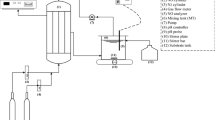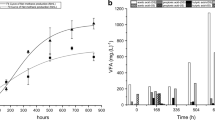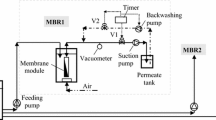Abstract
Hollow-fiber membrane bioreactors were developed with granular activated carbon (GAC) for the biodegradation of phenol using Pseudomonas putida. Hollow fibers showed similar structure with/without GAC incorporated; while GAC hollow fiber had a stronger phenol adsorption capacity. In batch biotransformation experiments, complete depletion of 1000 mg phenol l−1 (at which concentration free cells cannot grow) was accomplished in the reactor within 18 h in the hybrid bioreactor, comparing with 23 h in the GAC free bioreactor. Desorption and bioregeneration of the hollow-fiber membrane were believed to be the key for the enhancement of bioreactor performance. At continuous running, the GAC bioreactor showed its superiority over the GAC free bioreactor during start-up and elevated loading phase. More than 90% of the phenol was transformed in the GAC bioreactor when the phenol loading was <24 mg h−1. The better bioreactor performance may be due to the enhanced mass transportation and adsorption capacity with the incorporation of GAC.






Similar content being viewed by others
References
Ahmed AM, Nakhla GF, Farooq SJ (1995) Phenol degradation by Pseudomonas aeruginosa. J Environ Sci Health 30:99–107
Chung TS, Loh KC, Goh SK (1998a) Development of cellulose acetate membranes for bacteria immobilization to remove phenol. J Appl Polym Sci 68:1677–1688
Chung TS, Loh KC, Tay HL (1998b) Development of polysulfone membrane for bacteria immobilization to remove phenol. J Appl Polym Sci 70:2585–2594
Chung TP, Tseng HY, Juang RS (2003) Mass transfer effect and intermediate detection for phenol degradation in immobilized Pseudomonas putida systems. Process Biochem 38:1497–1507
Chung TP, Wu PC, Juang RS (2004) Process development for degradation of phenol by Pseudomonas putida in hollow-fiber membrane bioreactors. Biotechnol Bioeng 87:219–225
Erhan E, Yer E, Akay G (2004) Phenol degradation in a fixed-bed bioreactor using micro-cellular polymer-immobilized Pseudomonas syringae. J Chem Technol Biotechnol 79:195–206
Ehrhart HM, Rehm HJ (1985) Phenol degradation by microorganisms adsorbed on activated carbon. Bioeng Biotechnol 21:32–36
Ha SR, Vinttnantharat S, Ozaki H (2000) Bioregeneration by mixed microorganisms of granular activated carbon loaded with a mixture of phenols. Biotechnol Lett 22:1093–1096
Juarez-Ramirez C, Ruiz-Ordaz N, Cristiani-Urbina E, Galindez-Mayer J (2001) Degradation kinetics of phenol by immobilized cells of Candida tropicalis in a fluidized bed reactor. World J Microbiol Biotechnol 17:697–705
Keweloh H, Heipieper HJ (1989) Protection of bacteria against toxicity of phenol by immobilization in calcium alginate. Appl Microbiol Biotechnol 31:383–389
Lin JE, Wang HY (1991) Degradation of pentachlorophenol by non-immobilized, immobilized and co-immobilized Arthrobacter cells. J Ferment Bioeng 72:311–314
Prieto MB, Hidalgo A, Serra JL, Llama MJ (2002) Degradation of phenol by Rhodococcus erythropolis UPV-1 immobilized on Biolite in a packed-bed reactor. J Biotechnol 97:1–11
Razo-Flores E, Iniestra-Gonzalez M, Field JA (2003) Simultaneous biodegradation of a phenol and 3,4-dimethylphenol mixture under denitrifying conditions. J Environ Eng 129:999–1006
Sa CSA, Boaventura R (2001) Biodegradation of phenol by Pseudomonas putida DSM 548 in a trickling bed bioreactor. Biochem Eng J 9:211–219
Sirotkin AS, Koshkina LY, Ippolitov KG (2001) The BAC-process for treatment of wastewater containing non-ionogenic synthetic surfactants. Water Res 35:3265–3271
Tope AM, Srinivas N, Kulkarni SJ, Jamil K (2001) Mesoporous molecular seize (MCM-41) as support material for cell immobilization and transformation of 2,4,6-trinitrotoluene (TNT): a novel system for cell immobilization. J Mol Catal B 16:19–27
Vinod AV, Reddy GV (2005) Simulation of biodegradation process of phenolic wastewater at higher concentrations in a fluidized-bed bioreactor. Biochem Eng J 24:1–10
Walker GM, Weatherley LR (1999) Biological activated carbon treatment of industrial wastewater in stirred tank reactors. Chem Eng J 75:201–206
Wang DL, Li K, Teo WK (2000) Highly permeable polyethersulfone hollow fiber gas separation membranes prepared using water as non-solvent additive. J Memb Sci 176:147–158
Zhu GH, Chung TS, Loh KC (2000) Activated carbon-filled cellulose acetate hollow-fiber membrane for cell immobilization and phenol degradation. J Appl Polym Sci 76:695–707
Zaisev GM (1995) Utilization of halogenated benzenes, phenols and benzoates by Rhodococcus opacus GM-14. Appl Environ Microbiol 61:4191–4193
Acknowledgement
The author is appreciative of the research fund provided by the State Key Laboratory of Hydrology-Water Resources and Hydraulic Engineering (No.2006412411).
Author information
Authors and Affiliations
Corresponding author
Rights and permissions
About this article
Cite this article
Li, Y., Wang, C. Phenol biodegradation in hybrid hollow-fiber membrane bioreactors. World J Microbiol Biotechnol 24, 1843–1849 (2008). https://doi.org/10.1007/s11274-008-9699-1
Received:
Accepted:
Published:
Issue Date:
DOI: https://doi.org/10.1007/s11274-008-9699-1




